最新人教版高中英语选修8全册教案
最新人教版高中英语选修8全册教案
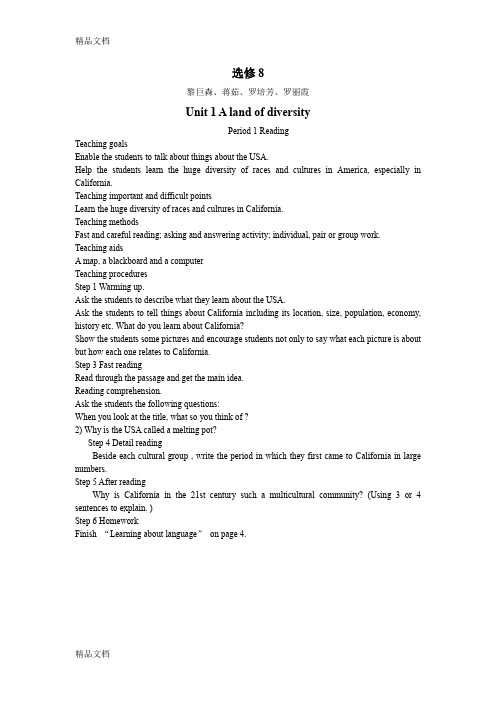
选修8黎巨森、蒋茹、罗培芳、罗丽霞Unit 1 A land of diversityPeriod 1 ReadingTeaching goalsEnable the students to talk about things about the USA.Help the students learn the huge diversity of races and cultures in America, especially in California.Teaching important and difficult pointsLearn the huge diversity of races and cultures in California.Teaching methodsFast and careful reading; asking and answering activity; individual, pair or group work. Teaching aidsA map, a blackboard and a computerTeaching proceduresStep 1 Warming up.Ask the students to describe what they learn about the USA.Ask the students to tell things about California including its location, size, population, economy, history etc. What do you learn about California?Show the students some pictures and encourage students not only to say what each picture is about but how each one relates to California.Step 3 Fast readingRead through the passage and get the main idea.Reading comprehension.Ask the students the following questions:When you look at the title, what so you think of ?2) Why is the USA called a melting pot?Step 4 Detail readingBeside each cultural group , write the period in which they first came to California in large numbers.Step 5 After readingWhy is California in the 21st century such a multicultural community? (Using 3 or 4 sentences to explain. )Step 6 HomeworkFinish “Learning about language”on page 4.Period 2 Extensive ReadingTeaching aims: 1. Improve Ss’ abil ity of reading2. 德育目标:了解美国多元文化,进一步培养学生跨文化交际意识,为终身学习奠定良好基础。
选修八教案英语高中模板
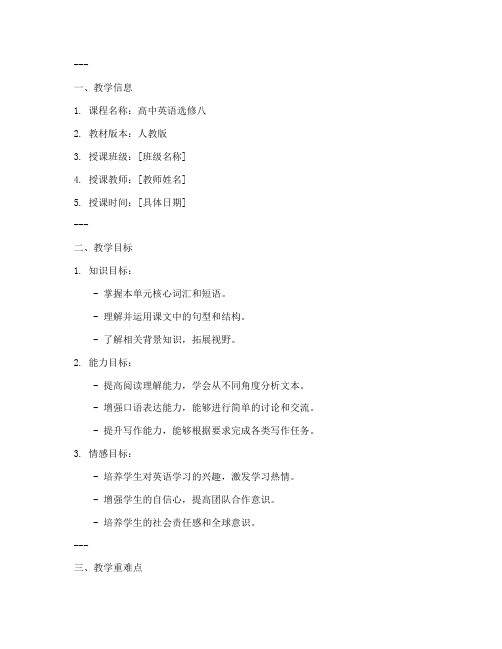
---一、教学信息1. 课程名称:高中英语选修八2. 教材版本:人教版3. 授课班级:[班级名称]4. 授课教师:[教师姓名]5. 授课时间:[具体日期]---二、教学目标1. 知识目标:- 掌握本单元核心词汇和短语。
- 理解并运用课文中的句型和结构。
- 了解相关背景知识,拓展视野。
2. 能力目标:- 提高阅读理解能力,学会从不同角度分析文本。
- 增强口语表达能力,能够进行简单的讨论和交流。
- 提升写作能力,能够根据要求完成各类写作任务。
3. 情感目标:- 培养学生对英语学习的兴趣,激发学习热情。
- 增强学生的自信心,提高团队合作意识。
- 培养学生的社会责任感和全球意识。
---三、教学重难点1. 重点:- 课文核心词汇和短语的理解与应用。
- 句型和结构的运用。
- 阅读理解能力的提升。
2. 难点:- 阅读长难句的能力。
- 口语表达的流畅性和准确性。
- 写作技巧的掌握。
---四、教学准备1. 教师准备:- 教学课件或黑板。
- 相关图片、视频等多媒体资源。
- 课文文本和练习题。
2. 学生准备:- 课前预习课文,了解背景知识。
- 准备相关词汇和短语。
- 准备口语表达和写作素材。
---五、教学过程1. 导入(5分钟)- 利用图片、视频等多媒体资源,激发学生学习兴趣。
- 提问引导学生回顾旧知识,为新课做好铺垫。
2. 新课导入(10分钟)- 阅读课文,理解课文大意。
- 分析课文结构,掌握课文内容。
3. 词汇教学(15分钟)- 介绍课文中的核心词汇和短语。
- 通过例句、游戏等方式,帮助学生记忆和运用。
4. 语法教学(10分钟)- 讲解课文中的句型和结构。
- 通过练习,帮助学生掌握语法知识。
5. 阅读理解(15分钟)- 阅读相关文章,回答问题。
- 分析文章结构,提炼关键信息。
6. 口语表达(15分钟)- 学生进行口语练习,分享自己的观点。
- 教师进行点评和指导。
7. 写作训练(15分钟)- 学生根据要求完成写作任务。
高中英语导学案与练习英语选修8人教版:精品教案选修八(36页)
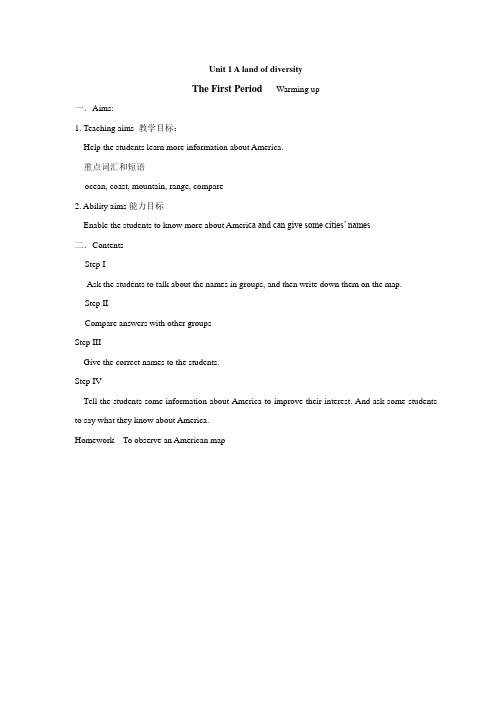
Unit 1 A land of diversityThe First Period Warming up一.Aims:1. Teaching aims 教学目标:Help the students learn more information about America.重点词汇和短语ocean, coast, mountain, range, compare2. Ability aims能力目标Enable the students to know more about Ameri ca and can give some cities‟ names二.ContentsStep IAsk the students to talk about the names in groups, and then write down them on the map.Step IICompare answers with other groupsStep IIIGive the correct names to the students.Step IVTell the students some information about America to improve their interest. And ask some students to say what they know about America.Homework To observe an American mapThe Second Period Reading一.Aims:1.Enable the students to talk about things about the USA.2.Help the students learn the huge diversity of races and cultures in America, especially inCalifornia.二.Contents:Step 1 Warming up.1.Ask the students to describe what they learn about the USA.2.Group work: look at the map of the USA with your group. Write on the map the names of as manyof the following as you can. Compare your names with other groups.Step 2 Pre-reading1.Ask the students to tell things about California including its location, size, population, economy,history etc. What do you learn about California?2.Show the students some pictures and encourage students not only to say what each picture is aboutbut how each one relates to California.Step 3 Fast reading1.Read through the passage and get the main idea.2.Reading comprehension.Ask the students the following questions:1)When you look at the title, what so you think of ?A land of differences. California is a land of great differences —differences in climate, in landscape and attitude.2) Why is the USA called a melting pot?There are many immigrants to the USA and there are many cultures and nationalities. So it is a place in which people, ideas, etc of different kinds gradually get mixed together.3.Beside each date note down an important event in Californian history.Step 4 Detail readingBeside each cultural group , write the period in which they first came to California in large numbers.Step 5 After readingWhy is California in the 21st century such a multicultural community? (Using 3 or 4 sentences to explain. )Step 6 HomeworkFinish “Learning about language” on page 4.The Third Period Language Points 一.Aims:1.Learn expressions and phrases.2.Learn language points.二.Contents:1. means: a method or a way of doing. 方式,方法,手段(但复数同形)Translate:一切可能的办法都试过了。
选修8全册精品教案共47页

普通高中课程标准实验教科书英语选修8全册教案Unit 1 A land of diversityThe First Period Warming up一.Aims:1. Teaching aims 教学目标:Help the students learn more information about America.重点词汇和短语ocean, coast, mountain, range, compare2. Ability aims能力目标Enable the students to know more about America and can give some cities’ names二.ContentsStep IAsk the students to talk about the names in groups, and then write down them on the map.Step IICompare answers with other groupsStep IIIGive the correct names to the students.Step IVTell the students some information about America to improve their interest. And ask some students to say what they know about America. Homework To observe an American mapThe Second Period Reading一.Aims:1.Enable the students to talk about things about the USA.2.Help the students learn the huge diversity of races and cultures inAmerica, especially in California.二.Contents:Step 1 Warming up.1.Ask the students to describe what they learn about the USA.2.Group work: look at the map of the USA with your group. Write onthe map the names of as many of the following as you can. Compare your names with other groups.Step 2 Pre-reading1.Ask the students to tell things about California including its location,size, population, economy, history etc. What do you learn about California?2.Show the students some pictures and encourage students not only tosay what each picture is about but how each one relates to California. Step 3 Fast reading1.Read through the passage and get the main idea.2.Reading comprehension.Ask the students the following questions:1)When you look at the title, what so you think of ?A land of differences. California is a land of great differences —differences in climate, in landscape and attitude.2) Why is the USA called a melting pot?There are many immigrants to the USA and there are many cultures and nationalities. So it is a place in which people, ideas, etc of different kinds gradually get mixed together.3.Beside each date note down an important event in Californian history.Step 4 Detail readingBeside each cultural group , write the period in which they first came to California in large numbers.Step 5 After readingWhy is California in the 21st century such a multicultural community? (Using 3 or 4 sentences to explain. )Step 6 HomeworkFinish “Learning about language” on page 4.The Third Period Language Points一.Aims:1.Learn expressions and phrases.2.Learn language points.二.Contents:1. means: a method or a way of doing. 方式,方法,手段(但复数同形)Translate:一切可能的办法都试过了。
高中英语人教版选修8 全套学案 高考英语 必修八 精品学案打包p134

【学习目标】复习本单元重要知识点。
【学习重点,难点】会运用本单元重要知识点解决问题。
【课型】Revision【回顾预习】复习本单元知识点,为检测做准备。
【新知识学习】Step 1.Words:1清晰的_________ 2百分比_________ 3手段,方法________4人种的,种族的_________ 5出现,发生_________ 6苦难,困苦_________ 7选择_________ 8北极的_________ 9侄子_________10大多数,大半_________ 11繁荣_________ 12申请人_________13指出,表明_________14尽管,不管_________ 15牛(总称)_________16海关,关税_________17显而易见的_________ 18租用_________19感激的_________ 20 刹车_________ 21抓住________22无处_________ 23处罚_________ 24角度_________25改革_________ 26哀悼_________ 27滑动_________28、横渡__________ 29、行李___________ 30、插入,嵌入________31、正义,公平________32、公民的,国内的_______________Step 2.Phrases1.用…方法,借助__________2.习惯新的生活方式,谋生____________3.此外,除…之外还有____________4.与…斗争,与打架____________ 学习指导明确学习目标!词汇是基础我展示!我精彩!5.赢得…独立____________6.在…安顿下来,定居____________7.保持,继续,鼓起____________8.向……宣战____________9.收容, 吸收,包括____________ 10.许多, 大量____________11.某人自己的____________ 12.标出____________13 背靠背_________________14.继续存在________________15.(想法念头等)出现在某人脑海中_____________16.缆车_______________ 17. 溜走_________________18.申请____________19.对…有很好的了解______________20.出租21.与…合作/一起工作____________22.划线标出…界限____________23.精通24、由···组成25、信任,信仰26、据认为27、到···时候为止28、以大多数赢得29、以优异成绩30、绝不,绝非Task 3. Discussion and presentation(合作探究)小组讨论自主学习中的问题,并进行展示和点评,过程中要注意补充和质疑。
高二英语人教版选修8教案:Unit1AlandofdiversityPeriod2 Word版含解析

Unit 1 A land of diversityPeriod 2Language Study整体设计教学内容分析The emphasis of this period will be placed on the important new words,phrases and sentence patterns in Warming Up,Pre-reading,Reading,Comprehending and Discovering useful words and expressions in Learning about Language.There are altogether 47 new words and phrases in these five parts.14 of them are marked with triangles,which shows that the students needn't learn them by heart.It is enough to recognize them when meeting them while reading the passage.The other 33 should all be remembered,among which the following words and expressions are even more important:distinction,majority,percentage,live on,by means of,make a life,keep up.They are all very useful and important.So are the sentence patterns “California is the third largest state in the USA but has the largest population.”,“Exactly when the first people arrived in what we now know as California,no one really knows.” We ought to pay more attention to them.三维目标设计Knowledge and skills1.To get the students to learn to use the following important new words and phrases freely:distinction,majority,percentage,live on,by means of,make a life,keep up.2.To get the students to understand and use the following important and useful sentence patterns:(1)California is the_third_largest state in the USA but has the largest population.(2)Exactly when the first people arrived in what_we_now_know_as_California,no one really knows.Process and methods1.To help the students to understand the meanings of the above useful new words and expressions in the context,and then give some explanations about them,and at last offer some exercises to make the students master their usages.2.To ask the students to make their own sentences by imitating the above sentence patterns.3.At the end of the class,make students do more exercises for consolidation.In doing so,they can learn,grasp and use these important language points well.Emotion,attitude and value1.To stimulate students' interest in learning English.2.To develop students' sense of cooperation and teamwork.教学重点、难点1.Important new words and expressions:distinction,rnajority,percentage,live on,by means of,make a life,keep up2.Important and useful sentence patterns:(1)California is the_third_largest state in the USA but has the largest population.(2)Exactly when the first people arrived in what_we_now_know_as_California,no one really knows.3.Some difficult and long sentences in the text.教学过程Step 1RevisionⅠ.Write out the words in Column A according to the meanings in Column B.Column A Column B1.______ clearly different or belonging to a different type2.______ 3.______ 4.______ 5.______ 6.______ 7.______ 8.______ 9.______ 10.______ 11.______ 12.______ a quick increase of business activityto happen or exist in a particular place or situationa way of doing or achieving somethingto choose to do somethingmost of the people or things in a groupto show that a particular situation existseasy to notice,obviousto slide a short distance accidentally,and fall or lose your balance slightly not in any place or to any placeto improve a system,law,organization etc.by making a lot of changes to it the power you have because of your official positionⅡ.Translate the following phrases into Chinese.1.live on ____________2.by means of ____________3.make a life ____________ 4.keep up ____________5.back to back ____________ 6.team up with ____________7.mark out ____________ 8.take in ____________9.a good/great many ____________ 10.apply for ____________11.declare war on ____________ 12.rather than ____________Suggested answers:Ⅰ.1.distinct2.boom3.occur4.means5.elect6.majority7.indicate 8.apparent9.slip10.nowhere11.reform12.authorityⅡ.1.继续存在;继续生存2.用……办法;借助……3.习惯于新的生活方式、工作等4.坚持;维持;沿袭5.背靠背6.与……合作或一起工作7.画线,标出……界线8.包括,吸收9.许多,很多10.申请;请示得到11.对……宣战12.而不是Step 2Reading and findingGet students to read through Warming Up,Pre-reading,Reading,Comprehending and Discovering useful words and expressions in Learning about Language to underline all the new words and useful expressions or collocations in these parts.Read them aloud and copy them down in the exercise book.Step 3Exercises for useful words and expressions1.Turn to Page 4.Go through the exercises in Discovering useful words and expressions with students and make sure they know what to do.2.Give them several minutes to finish the exercises.They may first do them individually,and then discuss and check them with their partners.3.Check the answers with the whole class and explain the problems they meet where necessary.Step 4Vocabulary studyⅠ.简单知识扫描1.distinction(P1)【原句再现】It also has the distinction of being the most multicultural state in the USA,having attracted people from all over the world.加州与众不同之处在于它也是美国最具多元文化的一个州,它吸引了来自世界各地的人们。
高二英语人教版选修8教案:Unit1AlandofdiversityPeriod6 Word版含解析

Unit 1 A land of diversityPeriod 6Summing Up,Learning Tip and Assessment整体设计教学内容分析This is the last teaching period of this unit,so the emphasis should be placed on going over and summarizing what has been learned in this unit.It includes the following parts:Summing Up,Learning Tip,Checking Yourself and some other consolidation exercises.Summing Up summarizes the whole unit from the aspects of topic,vocabulary and grammar.The teacher can first use this part to let students sum up what they have learned in this unit and then let them find out what they can't understand very well.Learning Tip gives students instructions on what you should do in a conversation.Finally,ask students to finish Checking Yourself on Page 53 in the Workbook.This part aims at encouraging students to make a self-assessment after they finish learning this unit.It is very important to improve their learning.Of course,a testing assessment is also needed.In this period,the teacher can also provide more exercises to consolidate what students have learned in this unit.三维目标设计Knowledge and skills1.To get students to master all the useful new words and expressions in this unit.2.To have students understand the grammar item “noun clauses” better,and enable them to use the following structures correctly:(1)Exactly when the first people arrived in what_we_now_know_as_California,no one really knows.(noun clause as the object)(2)However,it_is_likely_that Native Americans were living in California at least fifteen thousand years ago.(It is likely that...)(3)It_is_believed_that before long the mix of nationalities will be so great that there will be no distinct major racial or cultural groups,but simply a mixture of many races and cultures.(It is believed that...)(4)What_attracts_people_to_California is its pleasant climate and relaxed lifestyle.(noun clause as the subject)3.To develop the students' ability to use the important language points in this unit.Process and methodsDesign some additional exercises for students to do in order that they can learn to use and grasp all the contents.Emotion,attitude and value1.To encourage students to learn more about California and Louis Armstrong,the grandfather of American jazz.2.To train the students to appreciate the foreign customs and cultures.教学重点、难点Using what they have learned in this unit to solve real problems.教学过程Step 1Revision1.Check the homework exercises.2.Dictate some useful new words and expressions in this unit.Step 2Lead-inAsk the students to turn to Page 9.Think about what they have learned in this unit and fill inthe chart to see how well and how much they have learned them.Step 3Summing upFive minutes for the students to summarize what they have learned in this unit by themselves.Then check and explain something where necessary.Suggested answers:(Students' answers may vary.)From this unit we have learned the most multicultural state in the USA,California.From the Workbook we have learned some other states in America,and have also learned about Louis Armstrong,the grandfather of American jazz.From this unit we have also learned:useful verbs:elect,boom,occur,indicate,slip,hire,reform,shave,mourn,grasp,insertphrasal verbs:live on,make a life,keep up,team up with,mark out,take in,apply for useful nouns:distinction,strait,means,majority,ministry,hardship,rail,percentage,Italy,Denmark,aircraft,Korea,Korean,Pakistan,Pakistani,immigration,crossing,vice,nephew,pole,applicant,customs,socialist,socialism,cattle,luggage,tram,brake,conductor,bakery,ferry,seagull,angle,punishment,justice,authorityuseful adjectives and adverbs:distinct,Arctic,Catholic,federal,racial,apparent,civil,thankful,apparentlyuseful expressions:by means of,back to back,a great/good manygrammar item:noun clausesStep 4PracticeShow the exercises on the screen or give out exercise papers.Ⅰ.Word spelling1.I had the d______ impression that I was being watched.2.It didn't o______ to him that his wife was having an affair.3.She was e______ to take early retirement instead of moving to the new location.4.In the nursing profession,women are in a/the m______.5.She i______ to me(that)she didn't want me to say anything.6.It was becoming increasingly a______ that he could no longer look after himself.7.There's no j______ in the world when people can be made to suffer like that.8.For years I was an alcoholic,but I r______ when the doctors said that I had only six months to live.9.Be careful you don't s______—the floor's wet.10.She had to b______ hard to avoid running into the car in front.Ⅱ.Complete the following sentences according to the Chinese given.1.She tried to tell the story ____________(借助)sign language.2.Does it ever ____________(你可曾想到)he may be at home?3.Those houses are so strongly built that they would ____________(不倒)even in a violent earthquake.4.I've known her for ____________(许多)years.5.The university is ____________(与……合作)a school in England for the research project.6.They ____________(画出)a tennis court on the lawn.7.We need to ____________(申请)planning permission to build a house.8.Stand ____________(背靠背)and we'll see who's the tallest.9.The memory of those terrible days ____________(永存).10.The black dress ____________(吸收)a lot of heat from the sun.Ⅲ.Translate the following sentences into English.1.汤姆觉得把工作与乐趣结合起来不容易。
英语选修8全册精品教案1

普通高中课程标准实验教科书英语选修8全册教案Unit 1 A land of diversityThe First Period Warming up一.Aims:1. Teaching aims 教学目标:Help the students learn more information about America.重点词汇和短语ocean, coast, mountain, range, compare2. Ability aims能力目标Enable the students to know more about America and can give some cities‟ names二.ContentsStep IAsk the students to talk about the names in groups, and then write down them on the map.Step IICompare answers with other groupsStep IIIGive the correct names to the students.Step IVTell the students some information about America to improve their interest. And ask some students to say what they know about America.Homework To observe an American mapThe Second Period Reading一.Aims:1.Enable the students to talk about things about the USA.2.Help the students learn the huge diversity of races and cultures inAmerica, especially in California.二.Contents:Step 1 Warming up.1.Ask the students to describe what they learn about the USA.2.Group work: look at the map of the USA with your group. Write on themap the names of as many of the following as you can. Compare your names with other groups.Step 2 Pre-reading1.Ask the students to tell things about California including its location, size,population, economy, history etc. What do you learn about California? 2.Show the students some pictures and encourage students not only to saywhat each picture is about but how each one relates to California.Step 3 Fast reading1.Read through the passage and get the main idea.2.Reading comprehension.Ask the students the following questions:1)When you look at the title, what so you think of ?A land of differences. California is a land of great differences —differences in climate, in landscape and attitude.2) Why is the USA called a melting pot?There are many immigrants to the USA and there are many cultures and nationalities. So it is a place in which people, ideas, etc of different kinds gradually get mixed together.3.Beside each date note down an important event in Californian history.Step 4 Detail readingBeside each cultural group , write the period in which they first came to California in large numbers.Step 5 After readingWhy is California in the 21st century such a multicultural community? (Using 3 or 4 sentences to explain. )Step 6 HomeworkFinish “Learning about language” on page 4.The Third Period Language Points一.Aims:1.Learn expressions and phrases.2.Learn language points.二.Contents:1. means: a method or a way of doing. 方式,方法,手段(但复数同形)Translate:一切可能的办法都试过了。
人教高中英语 选修8教案全
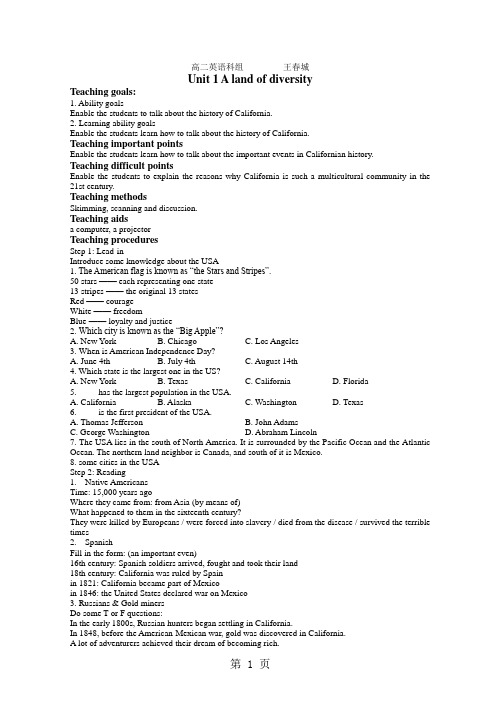
高二英语科组王春城Unit 1 A land of diversityTeaching goals:1. Ability goalsEnable the students to talk about the history of California.2. Learning ability goalsEnable the students learn how to talk about the history of California.Teaching important pointsEnable the students learn how to talk about the important events in Californian history.Teaching difficult pointsEnable the students to explain the reasons why California is such a multicultural community in the 21st century.Teaching methodsSkimming, scanning and discussion.Teaching aidsa computer, a projectorTeaching proceduresStep 1: Lead-inIntroduce some knowledge about the USA1. The American flag is known as “the Stars and Stripes”.50 stars —— each representing one state13 stripes —— the original 13 statesRed —— courageWhite —— freedomBlue —— loyalty and justice2. Which city is known as the “Big Apple”?A. New YorkB. ChicagoC. Los Angeles3. When is American Independence Day?A. June 4thB. July 4thC. August 14th4. Which state is the largest one in the US?A. New YorkB. TexasC. CaliforniaD. Florida5. ____ has the largest population in the USA.A. CaliforniaB. AlaskaC. WashingtonD. Texas6. ____ is the first president of the USA.A. Thomas JeffersonB. John AdamsC. George WashingtonD. Abraham Lincoln7. The USA lies in the south of North America. It is surrounded by the Pacific Ocean and the Atlantic Ocean. The northern land neighbor is Canada, and south of it is Mexico.8. some cities in the USAStep 2: Reading1.Native AmericansTime: 15,000 years agoWhere they came from: from Asia (by means of)What happened to them in the sixteenth century?They were killed by Europeans / were forced into slavery / died from the disease / survived the terrible times2.SpanishFill in the form: (an important even)16th century: Spanish soldiers arrived, fought and took their land18th century: California was ruled by Spainin 1821: California became part of Mexicoin 1846: the United States declared war on Mexico3. Russians & Gold minersDo some T or F questions:In the early 1800s, Russian hunters began settling in California.In 1848, before the American-Mexican war, gold was discovered in California.A lot of adventurers achieved their dream of becoming rich.California become the thirty-first state of the United states of American in 1850Why is California such a multicultural community? What problems do you think might arise? Step 4: Homework1. Underline the useful expressions2. workbookUnit 2 Cloning The First PeriodWarming Up, Pre-reading and Readinga. 重点词汇和短语clone,commercial,producer,undertake,arbitrary,object,forbid,accumulate,cast down,object to,the media,in favour ofb. 重点句子It is a way of….The fact is that….The question that occurred is….1.Ability goals 能力目标Enable the students to describe cloning: What is the advantages of cloning?What is the problems or dangers of cloning?What is your opinion of cloning?Teaching important points 教学重点How to describe cloning.Teaching difficult point 教学难点Help the students analyze the writing techniques of the article.Teaching methods 教学方法Skimming, task-based method and debate method.Teaching aids 教具准备A recorder, a projector and some slides.Teaching procedures & ways 教学过程与方式Step I Lead-inThis topic is difficult for students. So teacher should help the students learn more about it. Do this in the way of asking and answering questions.T: You can imagine how rapidly the modern science and technology develop. I think most of you must know something about space traveling, submarine exploration, robot, maglev train, gene engineering etc. But in recent years, a hot topic, cloning is often mentioned, especially when the cloning Dolly the sheep appeared. You may have first heard of cloning when Dolly the Sheep showed up on the scene in 2019. Cloning technologies have been around for much longer thanDolly, though. First things first, what is cloning and a clone? The dictionary says cloning is the technique of producing a genetically identical duplicate of an organism. A clone is said to be all descendants derived asexually from a single individual, as by cuttings, bulbs, by fission, by mitosis, or by parthenogenesis reproduction. It sounds very different and complicated to us. In fact, I mean, in our daily life, this happens often. For example, gardeners take cuttings from growing plants to make new ones. You often see that your mother picks a small branch from a growing plant to make a new one. If she likes this kind of flowers, she can do cloning. Cloning also happens in animals or human beings when twins identical in sex and appearance are produced from the same original egg. The fact is that cloning plants is straightforward but the cloning of animals is more complicated. The possibility of human cloning, raised when Scottish scientists at Roslin Institute created the much-celebrated sheep "Dolly", aroused worldwide interest and concern because of its scientific and ethical implications. You can give your questions if you are interested in this topic. I am here today one of the scientists who work in this field. I am ready to answer any of your questions. S: Now we know what is cloning. Are there different types of cloning?T: When the media report on cloning in the news, they are usually talking about only one type called reproductive cloning. There are different types of cloning however, and cloning technologies can be used for other purposes besides producing the genetic twin of another organism. A basic understanding of the different types of cloning is key to taking an informed stance on current public policy issues and making the best possible personal decisions. The following three types of cloning technologies will be discussed: (1) recombinant DNA technology or DNA cloning, (2) reproductive cloning, and (3) therapeutic cloning.S: Was Dolly created by what cloning? And why was Dolly so important?T: Reproductive cloning is a technology used to generate an animal that has the same nuclear DNA as another currently or previously existing animal. Dolly was created by reproductive cloning technology. She was the first mammal to be cloned from adult DNA taken from an adult cell. Previously, animals had only been cloned using embryo cells which already have the potential to become a complete embryo in its own right. The big breakthrough with Dolly was tomake a clone from an ordinary, adult cell − in this case from a female goat’s udder.S: Have you seen Jurassic Park? In this feature film, scientists use DNA preserved for tens of millions of years to clone dinosaurs. They find trouble, however, when they realize that the cloned creatures are smarter and fiercer than expected. Could we really clone dinosaurs.T: In theory? Yes. What would you need to do this? A well-preserved source of DNA from the extinct dinosaur, and a could serve as a surrogate mother. In reality? Probably not. It’s not likely that dinosaur DNA could survive undamaged for such a long time. However, scientists have tried to clone species that became extinct more recently, using DNA from well-preserved tissue samples. More questions about cloning are given in the appendix. The information above is for reference only. Or you can choose several students and ask them to act out a short play whose main topic is as follows:An old man who was dying left all his fortune to his own son. But the did not know that his son was cloned. So two same young men both claimed that they were the old man’s son. They quarreled and fought with each other; at last they went to the judge. The judge let them check DNA. The result was that their DNA was the same. Now even the judge did not know what to do.In this part the teacher can give the students some advice to act out. According to this play teacher ask the students several questions:1.Do you want to be cloned or not? Why?2.If you are the judge what will you do?3.Can you tell me the advantages of cloning?4.And what is the disadvantage?Look at picturesT: Look at the pictures and discuss which ones are natural clones and which ones are man – made. Then explain how they differ.S: I think the twins are natural clones and the Dolly sheep is man-made. T:You are right! Can you explain how they differ?S: The twins were born at the same time, but the Dolly sheep is man-made.T:Anything else? Who want have a try?S: I think the identical dog is man-made.T:Good JobStep II Pre-readingBefore class, ask the students to search for some information about this topic. Now show your questions on the screen, and then let them discuss with each other.T: Now please work in pairs and discuss about cloning. Then list the questions you want to find out.Share your list with your partner.Ss: Yes, sir / madam.Questions about cloning:1.What is a clone?2.How is a clone produced?3.What benefits can humans gain from cloning?4.What problems may arise when humans are cloned?Should we clone human?5.Could cloning replace sex as the means of creating new human life?6.Could a parent clone a child who is dying of a terminal illness?After a few minutes.T: Do you have other questions? Volunteer! S:I have! What is the writer’s opinion?T: Good job! I think many of you have questions, now let us read the article with the questions. Step III While- readingGet the students to comprehend the passage quickly and accurately and meanwhile help the students form a good habit of reading.T: Have you not the answers of your questions? Now please skim the passage fast to obtain a general understanding of the whole passage into several parts and find out the main idea of each part. Show the following.Para. 1 Cloning is a way of making an exact copy of another animal and plant.Para.2 Cloning has two major uses.Para. 3 The problems of Dolly. Para.4 The effect of Dolly.Para. 5 It is forbidden to clone human being.Step IV Post-readingAsk the students to read the passage again to finish three tasks.T: Now let’s listen to them. While listening, pay more attention to the correct pronunciation and tone. Then read the text by yourselves to get the answers to the three tasks. You can work in groups.T: First, What are the problems or dangers of cloning?S: Let me have a try! First, the cloned animals have the same illness of old animals and the same goes with the other species. Second, the cloned animals have short life and can cause moral questions. T: You are right! And what are the advantages of cloning?S: I know! Firstly, gardeners use it all the time to produce commercial quantities of plants.Secondly, it is valuable for research on new plant species and for medical research on animals.Thirdly, it suddenly opens everyone’s eyes to the possibility of using cloning to cure serious illnesses, and even producing human beings.T: What is the writer’s opinion? What do you think is the writer’s point of view in this reading passage? Is it in favour of cloning or against is?S1: I think the writer is in favour of it, because there are many advantages of cloning. It can help people solve many problems in our daily life.T: Good job! Yes, if we our human beings use the scientific technology properly it can bring many advantages to us!S: Why did Dolly’s appearance raise a storm of objections and have a great impact on the mediaand public imagination?T: Because nothing really prepared the world for the 2019 announcement that a group of Scottish scientists had created a cloned sheep named Dolly. Many folks believe that within the next decade, we will hear a more shocking announcement of the first cloned human. Scientists in South Korea have already created human embryonic stem cells through cloning. Until now, the idea of human cloning has only been possible through movie magic, but the natural progression of science is making human cloning a true possibility. We’ve cloned sheep, mice and cows, so why not humans?ExplanationT: Now let’s deal with some language points. Turn to page 11. Let’s look at the sentence: It is a wayof making an exact copy of another animal and plant. 全句汉语意思:它是一种精确复制另一个动物或植物的方式。
高中人教版英语选修8教学案:Unit+3+Section+Ⅲ+Grammar+—过去分词作定语、表语和宾语补足语.doc

Section_ⅢGrammar —过去分词作定语、表语和宾语补足语语法图解探究发现①The first thing I did was to see if there were any products that might help me, but there only seemed to be powders designed to kill snakes.②I placed the frozen bowl over the snakes' habitat and the ice-cubes on top of the bowl to keep it cool.③The next morning I carried in my hand a small net used for catching fish.④The criteria are so strict that it is difficult to get new ideas accepted unless they are truly novel.⑤Everybody was shocked at the news.⑥The lost time can never be found again.⑦The story written by a middle school student is popular in schools.⑧If you want to make yourself respected, you are above all to respect others.[我的发现](1)句①②③⑥⑦中的过去分词(短语)在句中作定语。
(2)句②⑥中为单个的过去分词作定语,常常放于被修饰名词的前面;句①③⑦中过去分词短语作定语,常常放于被修饰名词的后面。
(3)句⑤中的过去分词shocked作表语。
(4)句④⑧中的过去分词accepted和respected在句中作宾语补足语,与其所修饰的中心词new ideas, yourself构成被动关系。
高中人教版英语选修8教学案:Unit+3+Section+Ⅰ+Warming+Up+&+Reading+—+Pre-reading.docx
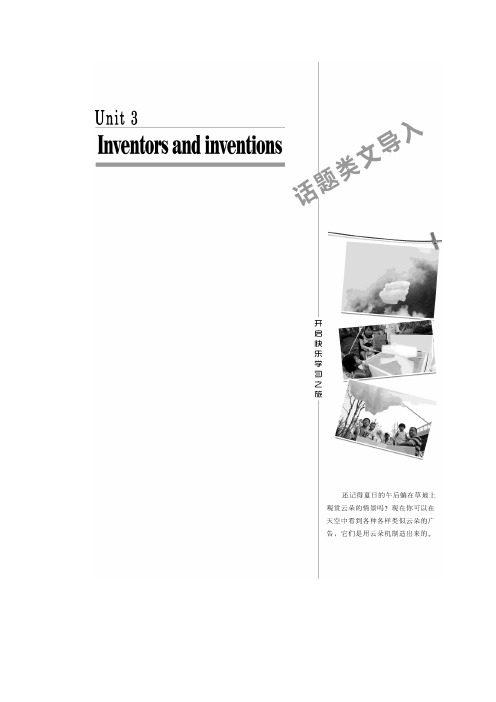
“That one looks just like a sheep!And look over there. That one looks like a horse!”Do you remember lying on your back in a grassy field on a summer afternoon,discovering the soft shapes in the clouds in the sky?Those were the good old days when you could see anything and everything in the clouds.,But now people look at the sky and see clouds in the shape of a motor company's advertising logo (标识),or a message inviting them to go out and buy a certain brand (品牌)of beer. These cloud pictures are not products of their imaginations. Instead,they are produced by a machine. These new floating advertisements are called Flogos;the name stands for “floating logos.” They're made from a mixture of soapy foam (泡沫)and a lighter-than-air gas such as helium,and they can be made into different sizes and shapes depending on the advertisement.,Flogos can last up to an hour if weather conditions are good,and they can fly several kilometers high. Advertisers can rent a Flogo machine for $2,500 a day. The set-up is normally performed within 1 to 2 hours,and it will release four Flogos per minute. Advertisers can fill the air with any shape or message they want.,Some people are worried that the Flogos might not be pollution-free (无污染的). However,the Flogo's inventor insists that the soap he uses is natural,and that a Flogo just dissipates (消失) in the air,leaving nothing behind. Though it may be true that Flogos are environmentally friendly,some people believe that the natural clouds in our memory may be replaced by man-made ones. They are afraid that soon there will be nowhere left where their imaginations can float freely.Section_ⅠWarming Up & Reading — Pre-reading [原文呈现][读文清障]THE PROBLEM OF THE SNAKESWhen I called up① my mother in the countryside on the telephone she was very upset. “There are some snakes in our courtyard②,” she told me. “Snakes come near the house nowand then③,and they seem to have made their home here, not far from④ the walnut⑤ tree. Can you get rid of⑥them please?”I felt very proud. Here was a chance for me to①call up给……打电话②courtyard/'kɔːtjɑːd/n.院子;庭院;天井③now and then偶尔;有时④far from句中意为“离……远”。
人教版高中英语选修八:Unit+2教案+
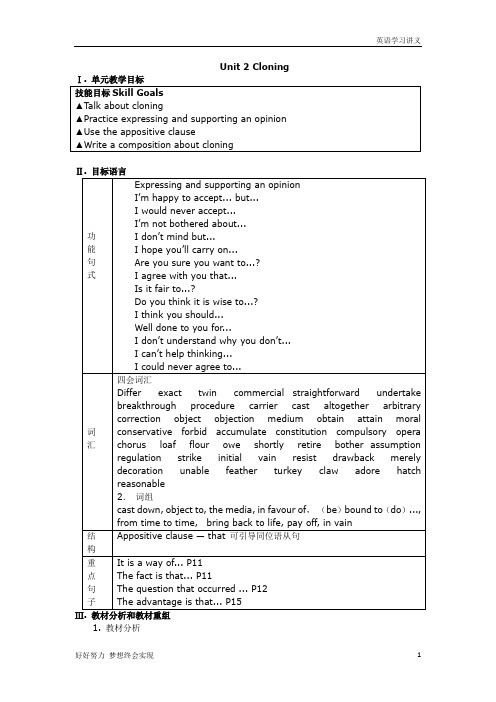
Unit 2 CloningⅢ. 教材分析和教材重组1. 教材分析本单元以Cloning为话题,旨在通过单元教学,使学生了解克隆技术的优缺点,学会表达和支持个人观点,能用所学的有关Cloning的词汇去表述自己对这一新技术的观点和看法。
1.1 Warming Up提供了四幅有关Dolly the sheep(多莉羊),A strawberry plant(草莓植物),Identical dogs(克隆狗) ,Twins(双胞胎婴儿)的图片,让学生用已有的知识和经验讨论对克隆技术的看法与观点。
1.2 Listening是关于人类克隆的听力材料,难度中等。
1.3 Speaking根据材料,四人小组合作,要求把自己对克隆婴儿的态度和感觉用相关的语言表达出来。
语言要得体,锻炼语段表达能力。
1.4 Pre-reading是Reading的热身活动,它要求采用与同学讨论交流的方式谈论有关克隆的相关知识。
1.5 Reading是一篇介绍克隆技术的说明文。
1.6 Comprehending第一题所给出的表格让学生根据课文内容列举克隆技术的优缺点;第二题让学生根据所拥有的知识来评价作者的观点;第三题要求学生用自己的语言阐述对克隆技术的观点并给出理由。
1.7 Learning about Language分词汇和语法两部分,其中Discovering useful words and expressions 是根据语境在运用中掌握词汇。
Discovering useful structures 是通过阅读和补全句子来练习。
1.8 Using Language中的Reading,Discussingand writing要求学生先读, 然后再完成四个任务型的作业,即 1. 讨论并回答三个问题;2. 讨论几种已经灭绝的动物,并且讨论哪种动物应该被恢复到这个世界上,并且给出理由;3. Listening and speaking 让学生根据所听到的内容选择并列出文中人物观点。
- 1、下载文档前请自行甄别文档内容的完整性,平台不提供额外的编辑、内容补充、找答案等附加服务。
- 2、"仅部分预览"的文档,不可在线预览部分如存在完整性等问题,可反馈申请退款(可完整预览的文档不适用该条件!)。
- 3、如文档侵犯您的权益,请联系客服反馈,我们会尽快为您处理(人工客服工作时间:9:00-18:30)。
人教版高中英语选修8全册教案Unit 1 A land of diversityPeriod 1 ReadingTeaching goalsEnable the students to talk about things about the USA.Help the students learn the huge diversity of races and cultures in America, especially in California.Teaching important and difficult pointsLearn the huge diversity of races and cultures in California.Teaching methodsFast and careful reading; asking and answering activity; individual, pair or group work. Teaching aidsA map, a blackboard and a computerTeaching proceduresStep 1 Warming up.Ask the students to describe what they learn about the USA.Ask the students to tell things about California including its location, size, population, economy, history etc. What do you learn about California?Show the students some pictures and encourage students not only to say what each picture is about but how each one relates to California.Step 3 Fast readingRead through the passage and get the main idea.Reading comprehension.Ask the students the following questions:When you look at the title, what so you think of ?2) Why is the USA called a melting pot?Step 4 Detail readingBeside each cultural group , write the period in which they first came to California in large numbers.Step 5 After readingWhy is California in the 21st century such a multicultural community? (Using 3 or 4 sentences to explain. )Step 6 HomeworkFinish “Learning about language”on page 4.Period 2 Extensive ReadingTeaching aims: 1. Improve Ss’ ability of reading2. 德育目标:了解美国多元文化,进一步培养学生跨文化交际意识,为终身学习奠定良好基础。
PART I READING (P8)Step 1. Fast reading: SB P7 PART 1.Step 2. Careful reading: Read George’s diary and answer the 5 questions on Page9 PART 2Step 3. Pay attention to the main words, phrases and sentences(根据学生实际由集体备课确定)PART II READING TASK(WB P51)Step 1. Fast reading to find the main topic of each paragraph:Step 2. T explains some difficult points.(由集体备课确定)Step 3. Homework :read the passage fluently and recite some parts.Period 3 GrammarTeaching aimsEnable the students to use the Noun Clauses as the subject, object, predicative and oppositive. Help the students learn how to use the Noun Clauses.Teaching important and difficult pointsDiffer the noun clauses.Teaching methodsAnalysis and have some discussions.Teaching proceduresStep 1 PreparationAsk the students to underline the noun clauses in the following sentences. Then tell what types of noun clauses they are.1)Whether native Americans arrived in California 15,000 years ago or 14,000 years ago is not important. Subject clause(主语从句)2)The fact that they arrived a long time before Europeans is what matters.Appositive clause(同位语从句) & Predicative clause(表语从句)3)I believe that the native Americans were treated badly when the first Europeans came. Object clause(宾语从句)Step 2 DiscussionAsk the students to differ the Noun Clauses as the subject, object, predicative and oppositive. Step 3 Analysis1.高考考查热点:1)名词性从句的语序(陈述句语序);2)几对重要关联词的区别:whether\if, what\that, what\whatever, who\whoever, etc;3)it用作形式主语或形式宾语代替主语从句或宾语从句;4)根据具体情景选用适当的关联词。
2.根据例句,讨论:1)whether\if的区别I. Please tell me if/whether you will go to the lectures tomorrow.II. It all depends on whether the sky will clear up.III. The question is whether the film is well worth seeing.IV. Whether he will be well tomorrow I’m not sure.V. Whether it is true remains a problem.A.引导宾语从句,位于及物动词后B.引导宾语从句,位于介词后C.引导宾语从句,放句首D.引导表语从句,主语从句或同位语从句whether: A, B, C, Dif: A2)What\that的区别I. I think that it is unnecessary for me to speak louder.II. His mother is satisfied with what he has done.III. That he was able to come made us happy.IV. This is what makes us interested.3)who\whoever; what\whatever的区别I. The spoken English competition is coming. Who will attend the meeting hasn’t been decided yet.II. I believe whoever takes part in the competition will try his best.III. Can you tell me what you would like to order?IV. Whatever happens, don’t be surprised.4)常见的it作形式主语的结构I. It is a fact that he won the match.II. It is necessary that we do study the English.III. It is known to all that light travels in straight lines.Step 4 Practice1)Exs.3&4, Students Book P52)Make sentences using noun clauses as the subject, object, predicative and appositive.Step 5 Homework1. Review what we have learnt today.2. Translate sentences:1)显而易见, 英语很重要.(主语从句) 2)玛利认为他会帮助她.(宾语从句)3)我从来未到过那儿这事实是真的.(同位语从句)4)问题是我们下一步该怎么做.(表语从句)Period 4 Listening and speakingTeaching goalsTrain their listening and speaking abilities.eaching important and difficult pointsHelp the students to talk about position, space and direction and illustrate ways that listeners indicate that they are listening to the speaker.Teaching methodsPair work and group work, discussion and cooperationTeaching aidsA recorder, a computer, and a blackboardTeaching proceduresStep1 ListeningThe first time the students listen to the tape they are expected to listen for the gist only. Read Ex1 on page 6 with students so that they know what to listen for and play the recording right through without stopping.4 Geographic areas of CaliforniaEvery culture has its own ____music__, ___festivals_____, food and art.Most interesting. Wish you were here. Give my love to Paula.GeorgeTell the students that when they listen to this time they are to focus on what Christie, who is mainly listening, says. Play the tape and stop after each thing that Christie says so that students can write down her words according to the chart on page 7.4.Get the students to compare their answers with their partners and check the answers.Step 2 SpeakingWith a partner hold a telephone conversation about a place you have visited recently.Sit back to back with your partner so you can’t see each other.3. Swap roles. Partner B tells Partner A about his\her visit.Step 3 HomeworkWrite a short passage about the place they have visited recently.Period 5 Using LanguageTeaching goalsTarget languageUseful words and expressions: luggage, tram, apparently, slip, bakery, ferry, hire, seagull, immigration, team up with, mark out, take in, a great many.Teaching important and difficult pointsImprove the students’ reading ability (skimming and scanning).enable the students to grasp the useful words and expressions.Teaching methodsReading, discussion, cooperative learningTeaching procedures:Step 1 Lead-inLook at George’s photos. Then quickly read George’s diary. Write the days he saw these things under the photos.Read George’s diary more slowly and answer the questions.Step 2 Language pointsTeam up with: make an effort in cooperation with; work together with与……协力从事,合作Translate:He teamed up with an experienced worker in the project.2.hire 解雇fire 租,雇佣1)You are _fired___, because you are so lazy for the work.理解4)Don’t let yourself be taken in by these politicians.欺骗Take off 拆开,拆散Take on 贬低, 贬损名誉等Take apart 从事,对…..产生兴趣,打听,占用空间或时间Take away from 脱下,脱去,起居,休假,离开Take up 开始雇佣,露出,承担,接受Step 3 Pair work and consolidation.Make sentences with the new words learned in this lesson.Step 4 HomeworkRead the passage againPrepare for the diction of the useful words and expressions of this unit3. Prepare for the writing of the next lesson.Unit 2 CloningPeriod 1 Warming Up, Pre-reading, Reading & ComprehendingTeaching Goals:1. To arouse Ss’ interest in learning about cloning2. To learn about the procedure of animal cloning and the life of Dolly the sheep3. To develop Ss’ some basic reading skills.Teaching Procedures:Step 1. Leading-inPurpose: To activate Ss and arouse them to want to know about cloning.Look at the following pictures and have a free talk.1.Do you know the name of the most famous sheep and how it is different from other sheep? Suggested Answer:Its name is the Dolly sheep. It was cloned while the others were born naturally. It is the copy of another sheep.2.What is cloning?Suggested Answer:Cloning is a way of making an exact copy of another animal or plant.Step 2. Warming UpPurpose: To lead Ss to the topic of this unit through the discussionTo get Ss to look at the pictures and discuss how they differSuggested Answer:The first picture shows “identical dogs”. The smaller of the two dogs must be a man-made clone of the larger one. The other picture is about human twins. They are identical in sex and appearance and are good examples of natural clones.Step 3. Pre-readingPurpose: To arouse S s’ interest in the text and encourage Ss to predict the content of the text.Get students to discuss what the passage talks about and how they understand the meaning of the title “Cloning : Where is it leading us?”Ask Ss to talk about the following questions.(1) What is cloning?(2) How is a clone produced?(3) What’s the function of cloning?(4) What’s the effec t of the cloning?Step 4. Fast readingPurpose: To get Ss to get some useful information.1. Ask Ss to listen to the text and try to get the main idea of the text.2. Ask Ss to read the text quickly and answer the following questions.Suggested Answer: (1) How many female sheep participate in the cloning of a new sheep? Three sheep.Step 5. Intensive reading做《三维设计》。
